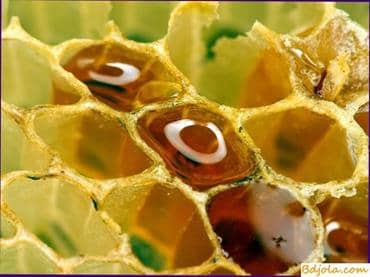
For honey bees, as we have already said, the strict distribution of work among family members is characteristic. This creates order in the family, ensures rapid performance of all kinds of work.
The “professional specialization” of worker bees is determined by their age. Young people usually do only household chores inside the nest, and middle and older bees, stronger and more familiar with the terrain, fly for nectar, pollen and water.
The bee-builder performs at the same time another very important job – takes nectar from bees-gatherers, puts it into loose honeycomb and processes it into honey. Work on nectar further strengthens the function of the wax glands. In addition, it tampers in flower cells pollen, discarded by bee-gatherers, wets it with honey.
When the worker bee turns 20 days and her glands cease to excrete the wax, she flies out to collect the feed. Now the bee deals with flowers. Until the end of her life she looks for and collects nectar and pollen, scrapes propolis from the kidneys, brings water to the nest, almost never again returning to endless chores around the house. Even in bad weather, when these bees are sitting in the nest, they remain indifferent to the hive problems, wait for the sunny days.
The oldest working bees (and the bee lives in the summer about 35-45 days) usually carry water into the nest. They are not far from the house. This work to old bees is quite possible, because it does not take much time to find water.
The bee-bearer flies up to 100 times a day, whereas the pollen picker does two or even three times less departures, and the extracting nectar manages to make only 10-20 flights. The bee dies in flight. Until the last second she works for the benefit of the family.
When a special or exceptional condition develops in nature or a nest, the age-related professional division of labor is disrupted. If many plants blossom and they begin to abundantly allocate nectar, then, obeying the instinct of fodder harvesting, highly developed in honey bees, behind it fly bees quite young, 7-10 days old, who have not yet had time to take part even in construction work. The younger become also the adopters, overloading the nectar into the cells. The whole family is included in the honey crop and in a short time makes a large supply of honey. The aggravated instinct of feed production rebuilds the activities of the whole family.
A young family, settled in a hollow or in a hive, immediately all included in the construction of the nest, although the bees are not the same age.
If, suddenly, during the processing of fields by pesticides in the family, flight birds die, bees and it will remain without pickers, honey bees are switched to the extraction of honey, by the time they are not ready for this. Thus, losses are restored.
The family of bees, therefore, is able in a short time to mobilize and direct its reserves to the most important work. This property of bees allows you to quickly respond to any environmental influences, both favorable and unfavorable.
Under unusual circumstances that threaten the family with death, even in old bees that have passed through all stages of the work biography, both dairy and wax glands can start functioning again. And they will again return to feeding the larvae and building a nest. Hence, environmental factors determine the behavior of the family.
The bee family is characterized not only by the clear distribution of labor between individual bees, but also by the collective performance of work. One group of bees feeds the larvae, the other builds honeycombs, the third extracts food. After all, one bee, say beekeepers, does not train a lot of nectar. Only by joint efforts of a large mass of gatherers can you prepare food for food and for stock. Powerless to do anything and one bee-builder.
In the bee family, all its members are interdependent and equal. Nobody enjoys any privileges, including the uterus – the central figure of the community. If she begins to lay less eggs, the bees will immediately replace her with a young, more prolific. Here, all are equally active in reacting to any signals. With a hungry bee, everyone shares food, even the last crumbs; the assembler with the load is unloaded; that she began to do one, another continues, the third one ends. The family of bees is a world of work, mutual aid and discipline.
Перевозка пчел. Название пчел.
Young Beekeeper